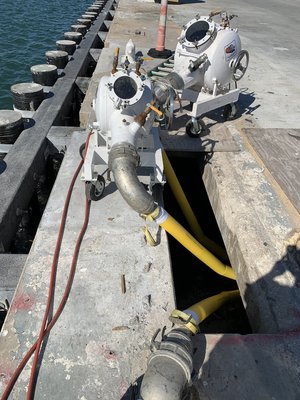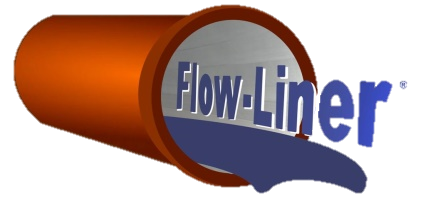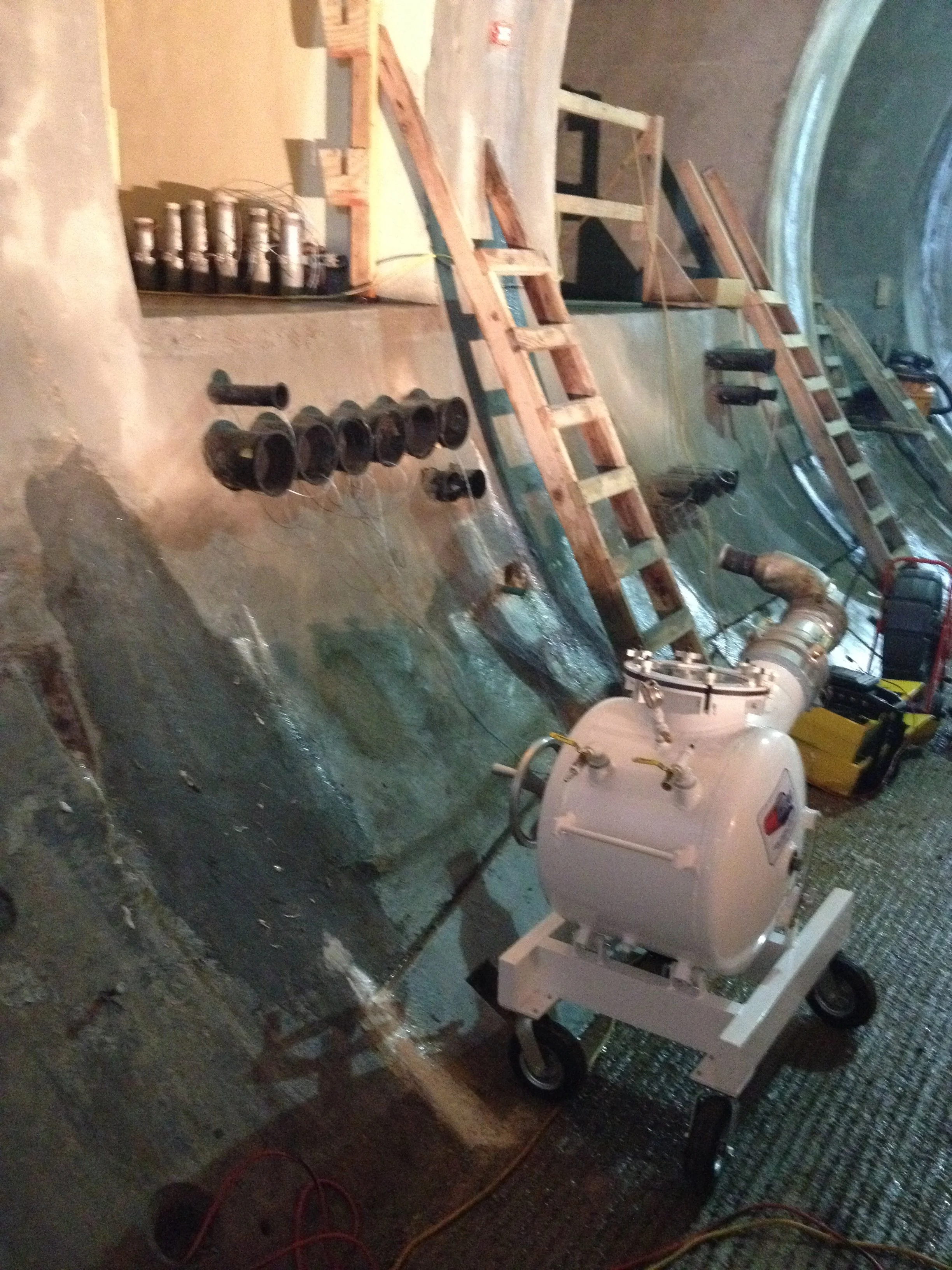Fixing Concrete Filled Conduits with CIP-Conduit
Conduit pipes are typically encased in concrete. Encasing a conduit in concrete will provide strength to the existing asset and will provide added protection to the conduit from unexpected external load and movement, reducing the risk of damage and the need for repairs. It also aids in protecting the conduits against liquid infiltration. A customer in Arizona was having some problems with their electrical conduits. After televising, the issue was quite clear - during the encasement process, the conduits had separated, allowing concrete to fill the conduit. To avoid breaking up the entire concrete encasement and start the project over, a Flow-Liner Certified Installer was contacted.
The Flow-Liner Certified Installer's first and most challenging objective was removing ten feet of cement from the conduit with a robotic cutter in a location that was over 100 feet in from the access point. Once the conduit was cleared and cleaned, the CIP-Conduit process could begin. The installer successfully lined approximately 140 feet of conduit -leaving them with a happy customer. CIP-Conduit® (Cured-In-Place Conduit) can be designed and installed according to your specifications and needs for underground conduits. A pre-site evaluation may be performed by one of our trained and Certified Installers. Once the necessary information is gathered, it is submitted to our Technical Design Division. Lining options will be submitted for customer review and approval.
Conduit Lining at the White House
Flow-Liner® Utilities was recommended for The White House project by one of the largest government contractors in the US. The Certified Flow-Liner® Utilities Installer had worked with the General Contractor just recently at a US Naval base relining underground conduits. The White House discovered water infiltration in their telecommunication conduits under the West Wing. CIP-Conduit® liner was efficiently installed by a Certified Installer, in one day- no demolition or excavation needed! More information and pictures can be found here.
Conduit Rehab at GEneral motors global tech center
The General Motors Global Technical Center is globally recognized as the preeminent innovation center for automotive engineering, design, and advanced technology. Here, the world’s best designers and engineers come together to help redefine the future of transportation. The 710-acre campus in Southeast Michigan is home to over 21,000 employees. The Tech Center opened in 1956 and is currently recognized as a National Historic Landmark.
A Certified Flow-Liner Installer was contacted to rehabilitate existing conduits at the General Motors Global Technical Center. First, a jetter was used to clean three conduit pipes, one 2" in diameter, two 4" in diameter, and each approximately 200' in length. Next, the CIP-conduit liner was installed, successfully navigating bends along the way. No excavation or demolition necessary for this CIP-Conduit project!




Flow-Liner's CIP-Conduit at Cape Canaveral
Cape Canaveral is located on the east coast of Florida in a region known as Space Coast. The Cape Canaveral Space Force Station and the Kennedy Space Center are both located in this region and are well-known launch sites for many US spacecrafts. A Certified Flow-Liner installer was contacted to utilize CIP-Conduit (Cured-in-Place-Conduit) at Poseidon Wharf East along Port Canaveral.
A contractor local to the Space Coast region discovered several 4" underground conduits in two separate duct banks were showing signs of deterioration. Traditional dig-and-replace would require the costly and inconvenient demolition of the duct banks and a large portion of the wharf itself. With CIP-Conduit, only small access pits were required to remedy this problem. The project entailed the rehabilitation of 12 conduits approximately 60 feet in length each. The local contractor prepared the small access pits and the ducts for the Flow-Liner installation crews. With two installers per crew, six conduits were successfully lined per day, totaling only two days of the Flow-Liner CIP-Conduit installers on site.






CIP-Conduit at Naval Station Norfolk
Naval Station Norfolk is a United States Navy base in Norfolk, Virginia. It supports naval forces in the United States Fleet Forces Command, those operating in the Atlantic Ocean, Mediterranean Sea, and the Indian Ocean. The installation occupies about 4 miles of waterfront space and 11 miles of pier. It is the world's largest naval station, with the largest concentration of U.S. Navy forces. General Contractor Blackwater Electric discovered the naval station had a need for trenchless technology and contacted a Flow-Liner Certified Installer. The contractor had found issues with stringing the naval station's underground electrical conduit lines and discovered the conduits were too congested to work in. The Certified Flow-Liner Installer performed a thorough cleaning procedure to open up the conduits. After the lines were cleaned and opened back up, approximately 3000 feet of conduits were lined using Flow-Liner's CIP-Conduit® inversion method. Both Blackwater Electric and Naval Station Norfolk were pleased with the use of Flow-Liner's trenchless technology, and happy to save time and money with CIP-Conduit lining.
National Grange Mutual Insurance
The National Grange Mutual Insurance building in Keene, NH had two 4-inch electrical conduits running approximately 100 feet from inside the building to a manhole vault in the street. The conduits were packed with debris and heavy scale for the last 30 feet, preventing the electrical contractor, F.H. Hamblet, Inc., from pulling new power cables through the existing conduit. Digging and replacement would have been costly and highly disruptive to the facility and its 600 employees.
Using Flow-Liner® trenchless technology, a Flow-Liner Certified Installer cleaned the conduits with a small gas jetter and drain machine before installing the 4-inch CIP-Conduit® Lining System. Each 100-foot line was successfully rehabilitated, including a 45° bend at 70 feet, with no reinstatements required.
The electrical conduits were restored to a clean, like-new condition without any excavation or disruption to building operations. The Project Manager from F.H. Hamblet, Inc. was very pleased with the outcome, stating: “The conduit lining saved us from having to dig up and replace the conduit, which would have been very costly and inconvenient. We highly recommend your product and consider it a valuable option compared to pipe replacement.”
Cedar Rapids Water Treatment Facility
Originally built in 1929, the Cedar Rapids Water Treatment Facility expanded in 1949 and 1969, with an advanced ultraviolet (UV) station added in 2008. The UV station is one of only a few in operation nationwide and is capable of disinfecting up to 40 million gallons of water per day. The facility’s four UV trains each contained multiple 3-inch electrical conduits with water infiltration below floor level. These conduits—encased in concrete and running beneath operating machinery—carried multiple power lines, making excavation and replacement impossible without major disruption. Miron Construction Company contacted Flow-Liner® for a trenchless, non-invasive repair option.
Using Flow-Liner® technology, a Flow-Liner Certified Installer rehabilitated twenty 3-inch conduits with the 3”-2mm CIP-Conduit® Lining System, an ambient-cure CIPP solution. The first ten lines were inverted vertically from the UV train room, while the remaining ten were lined from the second-floor ballast room—dropping 30 feet before extending horizontally. Each liner cured overnight at 12 psi with excellent results.
All twenty conduits were successfully sealed and restored in less than one week, with no impact on the plant’s daily operations. The Project Executive from Miron Construction Company commented: “We found your lining system to be unique and effective, ultimately repairing the conduit in place—thus replacement of the conduit was not necessary.”
Conduits at Grand Central Terminal
Grand Central Terminal, one of New York City’s most iconic landmarks, first opened in 1913 and continues to serve as a major transportation hub. Over the years, it has undergone several renovations and expansions, including the current East Side Access Project—a multi-billion-dollar effort to connect the Long Island Rail Road to Manhattan’s East Side. During the East Side Access construction, a newly installed 4-inch electrical conduit located 100 feet underground within a utility tunnel began leaking. The 60-foot conduit, which contained two 90° and two 45° bends, was encased in six feet of concrete and positioned nearly three-quarters of a mile into the tunnel. Excavation and replacement were not feasible due to cost, depth, and active construction around the area.
Using Flow-Liner® trenchless technology, a Flow-Liner Certified Installer rehabilitated the leaking conduit by installing the 4-inch CIP-Conduit® Lining System. This non-invasive cured-in-place method provided a seamless internal barrier to stop water infiltration—eliminating the need for costly excavation. The electrical conduit was successfully sealed and restored without disrupting construction progress. The Project Manager with the Granite–Traylor–Frontier (GTF) Joint Venture stated:
“The finished product exceeded our expectations and helped GTF close out an item of punchlist work that could have been more costly if not for the technology provided by your company. We would definitely utilize your services in the future and highly recommend your firm to any other contractors who experience a similar problem.”
San Onofre Nuclear Generating Station – San Clemente, CA
Located along the Pacific Coast in Southern California, the San Onofre Nuclear Generating Station (SONGS) was a major source of power for the region before being decommissioned. The facility remains an active site for maintenance, deconstruction, and utility infrastructure management to ensure environmental and safety compliance.During routine maintenance, several 3-inch electrical conduits running between underground vaults and control structures showed signs of deterioration and water infiltration. The conduits were encased in concrete and located beneath critical operating areas, making excavation impossible without halting work across multiple sections of the facility.
Using Flow-Liner® trenchless technology, a Flow-Liner Certified Installer rehabilitated the damaged conduits with the 3-inch CIP-Conduit® Lining System. The cured-in-place process created a seamless internal barrier that sealed the conduits against water intrusion while preserving existing power and communication lines.
The conduits were successfully sealed and restored without disruption to ongoing facility operations or environmental containment measures. The project was completed safely and on schedule, demonstrating Flow-Liner’s effectiveness in high-security, limited-access environments where excavation is not an option.
Download more information about Flow-Liner CIP-Duct projects Below:
AEP Canton Conduit Lining
AEP Eastland Mall Conduit Lining
AEP Indiana Michigan Conduit Lining
Columbus Castings Conduit Lining
Navy Carderock Division Conduit Lining
PECO Energy
National Grange Mutual Insurance





























